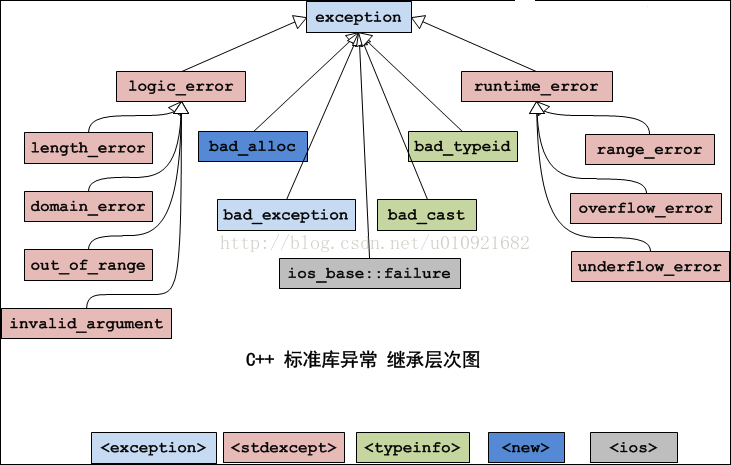原文链接:https://blog.csdn.net/u010921682/java/article/details/44842993
1,exception
头文件:
#include <exception>
C++ 可以把它用作其它异常类的基类。
代码可以引发exception异常,也可以把exception用作基类,
在从exception派生而来的类中重新定义一个名为what()的虚拟成员函数,
它返回一个字符串,该字符串随实现而异。
#include <exception>
class bad_hmean : public std::exception
{
public:
const char* what()
{
return "bad arguments to hmean()";
}
// ...
};
class bad_gmean : public std::exception
{
public:
const char* what()
{
return "bad arguments to gmean()";
}
// ...
};
如果不想以不同的方式捕获这些派生来的异常,可以在同一个基类处理程序中捕获它们:
try{
//...
}
catch(std::exception& e)
{
cout << e.what() << endl;
// ...
}
否则,应分别捕获它们。
C++库定义了很多基于exception的异常类型。
1,stdexcept 异常类
该文件定义了logic_error和runtime_error类,它们都是以公有类从exception派生而来的。

每个类所在的头文件在图下方标识出来.
标准异常类的成员:
① 在上述继承体系中,每个类都有提供了构造函数、复制构造函数、和赋值操作符重载。
② logic_error类及其子类、runtime_error类及其子类,它们的构造函数是接受一个string类型的形式参数,用于异常信息的描述;
③ 所有的异常类都有一个what()方法,返回const char* 类型(C风格字符串)的值,描述异常信息。
标准异常类的具体描述:
异常名称
描述
exception 所有标准异常类的父类
bad_alloc 当operator new and operator new[],请求分配内存失败时
bad_exception 这是个特殊的异常,如果函数的异常抛出列表里声明了bad_exception异常,当函数内部抛出了异常抛出列表中没有的异常,这是调用的unexpected函数中若抛出异常,不论什么类型,都会被替换为bad_exception类型
bad_typeid 使用typeid操作符,操作一个NULL指针,而该指针是带有虚函数的类,这时抛出bad_typeid异常
bad_cast 使用dynamic_cast转换引用失败的时候
ios_base::failure io操作过程出现错误
logic_error 逻辑错误,可以在运行前检测的错误
runtime_error 运行时错误,仅在运行时才可以检测的错误
logic_error的子类:
异常名称
描述
length_error 试图生成一个超出该类型最大长度的对象时,例如vector的resize操作
domain_error 参数的值域错误,主要用在数学函数中。例如使用一个负值调用只能操作非负数的函数
out_of_range 超出有效范围
invalid_argument 参数不合适。在标准库中,当利用string对象构造bitset时,而string中的字符不是’0’或’1’的时候,抛出该异常
runtime_error的子类:
异常名称
描述
range_error 计算结果超出了有意义的值域范围
overflow_error 算术计算上溢
underflow_error 算术计算下溢
例:logic_error下的
domain_error:定义域由参数的可能取值组成
invalid_argument:值域由函数可能的返回值组成,指函数传递了一个意料之外的值
length_error:指没有足够的空间来执行所需的操作,如string类的append()方法合并得到的字符串长度超过最大允许长度会引发该异常
out_of_bounds:通常指索引错误,如定义一个数组,其operator[]在使用索引无效时会引发该异常
一般而言:
logic_error系列异常表明存在可以通过编程修复的问题。
runtime_error系列异常表明存在无法避免的问题。
2,对于bad_alloc 异常与new
对于使用new导致的内存分配问题,C++的最新处理方式是让new引发bad_alloc异常。
头文件new包含bad_alloc类的声明,它从exception公有派生来。
#include <iostream>
#include <new>
#include <cstdlib>
using namespace std;
struct Big
{
double stuff[20000];
};
int main()
{
Big* pb;
try
{
cout << "Trying to get a big block of memory:\n";
pb = new Big[11000];
}
catch(bad_alloc& ba)
{
cout << "Caught the exception!\n";
cout << ba.what() << endl;
exit(EXIT_FAILURE);
}
cout << "Memory successfully allocated\n";
pb[0].stuff[0] = 4;
cout << pb[0].stuff[0] << endl;
delete [] pb;
return 0;
}
输出:
Trying to get a big block of memory:
Caught the exception!
bad allocation
这里,方法what()返回的字符串“std::bad_alloc".
3, 空指针与new
例:int* pi = new (std::nothrow) int;
int* pa = new (std::nothrow) int[500];
#include <iostream>
#include <new>
#include <cstdlib>
using namespace std;
struct Big
{
double stuff[20000];
};
int main()
{
Big* pb;
pb = new (std::nothrow) Big[11000];
if (pb == 0)
{
cout << "Could not allocate memory.Bye!\n";
exit(EXIT_FAILURE);
}
cout << "Memory successfully allocated\n";
pb[0].stuff[0] = 4;
cout << pb[0].stuff[0] << endl;
delete [] pb;
return 0;
}
输出:
Could not allocate memory.Bye!
————————————————